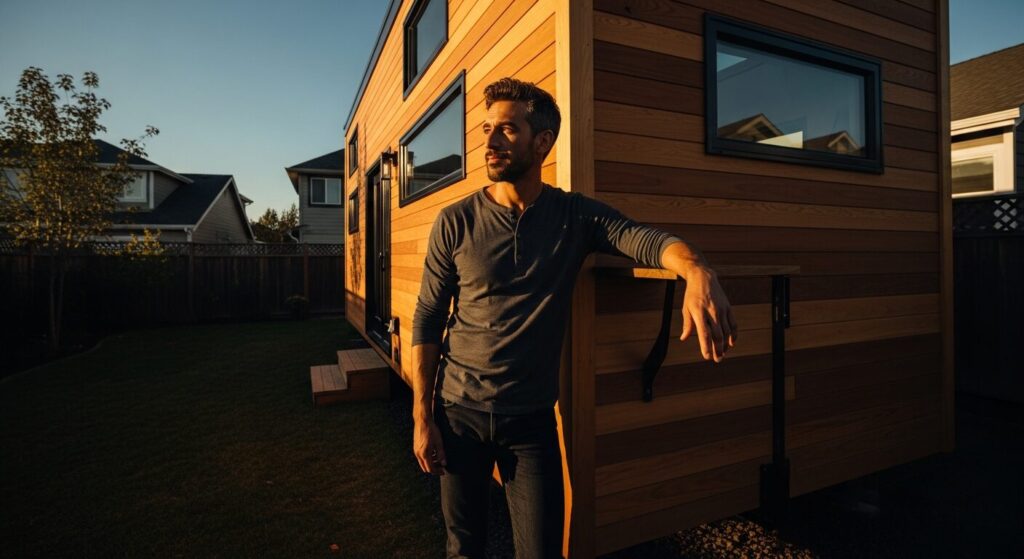
The tiny home movement is getting a massive upgrade, going from a niche curiosity to a full-blown housing solution. It’s like watching your favorite indie band suddenly headline a stadium tour! For years, dreamers of minimalist living have been wrestling with a tangled mess of outdated zoning laws, but the script is finally flipping. Cities across the U.S. are rolling out new, more welcoming regulations, and your tiny dream home might just have a place to call its own.
A Revolution in a Small Package: Why Cities Are Paying Attention
The buzz around tiny homes is about more than just cute, compact design; it’s a powerful response to the national housing affordability crisis. With 68% of tiny homeowners living mortgage-free, the financial freedom is a massive draw. Cities are now recognizing that these small dwellings can offer a viable path to homeownership and help increase housing density.
This shift in perspective is fueling a wave of regulatory reform from coast to coast. Lawmakers are finally seeing tiny homes not as a problem to be zoned out, but as an innovative component of the affordable housing solution. This momentum is creating unprecedented opportunities for builders and homeowners alike.
Leading the Way: Which Areas Are Now Tiny-Home-Friendly?
Several cities and counties are leading the charge by rewriting their rulebooks to embrace minimalist living. These progressive changes are making it easier than ever to build or place a tiny home legally.
This new wave of acceptance is evident in places like DeLand, Florida, which recently passed a groundbreaking ordinance to allow tiny home communities. Similarly, San Diego County, California, has officially added Tiny Homes on Wheels to its zoning ordinance, classifying them as accessory dwelling units (ADUs) and opening up thousands of backyards to new housing possibilities.
Key Changes in Pro-Tiny Home Ordinances:
- Accessory Dwelling Unit (ADU) Status: Many cities now explicitly permit tiny homes on wheels to be used as ADUs, providing rental income opportunities or space for family.
- Creation of Tiny Home Communities: Ordinances like the one in DeLand establish specific zoning for entire tiny home villages, complete with shared amenities and infrastructure.
- Reduced Lot Size Requirements: States like Texas and Maine are enabling the construction of single-family homes on smaller lots, a perfect fit for tiny home development.
- Clearer Building Standards: Forward-thinking regulations are providing specific building codes for tiny homes, distinguishing them from RVs and making them easier to permit and insure.
Navigating the Hurdles: What Challenges Still Remain?
Despite the positive momentum, the path to placing a tiny home isn’t entirely free of obstacles. The legal landscape is a patchwork, and what’s welcomed in one city might be forbidden just a few miles away. Aspiring owners must still navigate a few key challenges.
Community pushback and bureaucratic confusion can still create significant setbacks, as seen in cases where neighbors’ complaints have led to removal orders. Furthermore, utility requirements for water, sewer, and electricity can be a major sticking point, especially in municipalities that haven’t yet established clear guidelines for small dwellings.
Comparison: Tiny Home-Friendly vs. Restrictive Zoning
| Feature | Tiny Home-Friendly Approach | Restrictive Approach |
|---|---|---|
| Minimum Sq. Footage | No minimum, or allows for under 500 sq. ft. | Requires 700-1,000+ sq. ft. for a primary dwelling. |
| Foundation Type | Allows both permanent foundations and tiny homes on wheels (THOWs) as ADUs. | Only permits permanent foundations; THOWs are classified as RVs with limited stay times. |
| Placement | Permits tiny homes as primary residences on individual lots or in designated communities. | Restricts tiny homes to RV parks or only as temporary structures. |
| Utility Hookups | Clear guidelines for connecting to city water/sewer or for approved off-grid systems. | Vague or non-existent utility standards, create bureaucratic roadblocks. |
Your Blueprint for Success: What Aspiring Homeowners Should Do Now
So, what does this all mean for you? It means that with the right research, your tiny home dream is more achievable than ever. The first step is to become an expert on your local jurisdiction. Start by contacting your city or county planning and zoning department to get the most accurate, up-to-date information.
Distinguish between a tiny home on wheels (THOW) and one on a permanent foundation, as they are often regulated differently. Understanding all the options available is crucial, from buying your own rural land to finding a spot in a pre-approved tiny home community. This diligence will ensure your project moves forward smoothly, avoiding costly legal issues later on.

The landscape for tiny homes is changing faster than ever, unlocking incredible new doors for affordable, sustainable living. While hurdles remain, the momentum is undeniable as more cities recognize the value of minimalist lifestyles. By staying informed and doing your homework, you can confidently navigate this exciting new frontier and build the tiny home you’ve always envisioned.












